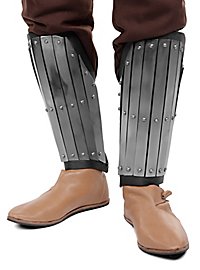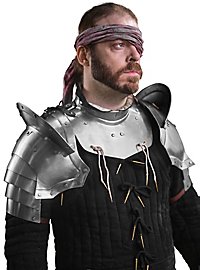Plate armors from various centuries in our Larp shop
The knight on horseback in his plate armor with shield and sword is perhaps the most well-known image of a warrior from the Medieval period. We have an understanding of medieval armors from the museum, and even today, knight armors and the occasional suit of armor adorn the long corridors in castles. Indeed, the production of steel knight armor experienced its heyday in the late Middle Ages and the Renaissance. The so-called "plattners" created works of art from steel using the mechanics of the time. Constructing such a knight's armor was time-consuming and expensive. The fact that often only knights could afford to wear plate armor had its reasons because plate or knight armor was very expensive in the Middle Ages, and usually only a man of status or noble was capable of paying for plate armor. But it truly provided reliable protection in battle and combat.
Metal Armours of the Renaissance & Antiquity at Andracor.
Also, in the Renaissance, metal armors were common in battle. There were special armors designed specifically for protection against certain weapons of the Middle Ages. A knight's armor and accessories especially had to withstand attacks from various weapons. Some wealthier Landsknechts could afford plate armors. And especially the knight armors of the Renaissance are custom-made marvels of the blacksmith's art. The German, Italian, English, and French armorers and smiths of the 15th - 16th centuries were in fierce competition for the best construction method and form of plate armor. The clean interlocking of metal plates guaranteed the knight's mobility in armor, often ensuring their survival in combat.
However, the use of plate armors is not limited to just the Middle Ages and the modern era.
Yet the development of the first plate armor occurred much earlier. Already in Antiquity, metal armors were used. The legionaries of the Roman Army used metal armors. The Lorica Segmentata was the choice for legionaries and centurions in ancient Rome. And even the Greek hoplites had bronze breastplates to protect their torsos. No matter which century you prefer, at Andracor, you can buy plate armor from various epochs and styles.
Buy Metal Armor & Knight Armor - Which One is Right for Me?
It's hard to imagine fighting in plate armor today! Unless you participate in a Larp or Reenactment. In a Larp, you probably don't start with a complete knight's armor and accessories. The normal beginner character also starts as a warrior, but modestly, for example as a squire, soldier, or mercenary in an army, and gradually builds up their equipment over time. Especially armor is still an investment today. Among armors, the plate armor looks the noblest and most impressive and protects the character with so-called armor points from the attacks of opponents. Plate armor can consist of various parts. And depending on the completeness of this knight's armor, one will be perceived more as a respected warrior in Larp.
Full suits of armor for knights in LARP!
A complete medieval armor is called full armor, and it goes from the helmet to the feet and covers the body almost completely in steel. Such armor is almost always reserved for knights or paladins in Larp. But whether you are looking for a simple Landknecht armor or want to buy a complete knight's armor, you are in the right place here at the Andracor Armor Shop. Here you will find typical medieval harnesses, such as the Churburg armor or even a complete Gothic armor as an impressive exhibit. You will also find some special pieces at Andracor, such as armored gloves, steel neck guards, leg bags, and elegant arm gear for lacing from the 16th century.
Metal Armor Parts - What Do Plate Armors Consist Of?
Plate armor parts such as torso, metal shoulders, knight helmets, as well as metal armguards and leg guards can be worn very individually, it is up to everyone to decide which part of the body they want to protect. But what belongs to a full armor for a knight and warrior in Larp?
The breastplate is naturally the central part of a steel armor. However, in Larp, many blows go to the arms, legs, and shoulder region, because blows to the head or stabs that would hit the torso are not allowed. Therefore, plate shoulders are just as essential as good metal armguards and matching leg guards for Larp warriors. The plates should fit comfortably and proportionally on the body and be flexible. The weight of the armor is also a significant factor, but the better the plate

































